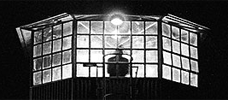Reviews
Todd Haynes
USA / Germany, 2007
Credits
Review by Jenny Jediny
Posted on 04 November 2007
Source The Weinstein Company 35mm print
Related articles
Reviews I’m Not There by Tom
Categories The 45th New York Film Festival
God, I’m glad I’m not me.
—Bob Dylan (reading a newspaper article about himself, 1966)
At the press screening for I’m Not There, I overheard the man sitting in front of me confide in his companion that he prefers “Robert Zimmerman’s” early work. I inwardly groaned, as only a self-admitting film snob can; this sort of elitism in music typically results in me hypocritically rolling my eyes, best explained by the fact that I find musical tastes more difficult to defend, a more intimate experience of art than literature, film, and the like. Despite my judgment, the comment proved surprisingly thought-provoking as I’m Not There unfolded on-screen. Todd Haynes’ self-proclaimed supposition on one of music’s most prominent artists deals extensively with the projected relationships we conjure between our idols and ourselves. It’s almost an unwieldy concept, and certainly an intimidating one, but focusing on Bob Dylan, shape-shifter through more than four decades of history, reveals an occasionally reckless, extremely imaginative Haynes who seems intent on challenging both himself and his audience.
Haynes’ has dipped into music history in previous work. The cult hit Superstar: The Karen Carpenter Story examines the singer’s rise to stardom and subsequent bout with anorexia (which eventually caused her death at age 32) through found footage, miniature sets and Barbie dolls (yes, Barbie dolls, and emotionally engaging ones to boot). A short, avant-garde film Superstar convincingly displays the pressures in the music industry against the delicate and dwindling self-confidence of Carpenter. Over a decade later, Haynes’ directed the decadent, if somewhat superficial Velvet Goldmine. Its excessive performances and art direction used to evoke the flair of the glitter rock era are tripped up by narrative stumbles (particularly the Citizen Kane allusions) but the film remains a guilty pleasure for many (including myself).
I’m Not There pushes itself wide open from the start, and is as experimental as the aforementioned films, but with a broader scope; Dylan is split into several - seven, to be exact - personas, notably portrayed by six actors varying in age, gender, and race. These individual portraits comprise what may be more easily defined by Dylan’s albums and distinctive musical periods: for example, the “Freewheelin’” folk phase, which spills over into the public’s claim on Dylan as a protest figure; the “Electric” period, namely involving the infamous 1965 Newport festival and a concert at London’s Royal Albert Hall the following year; or the mid-1970’s conversion to born-again Christianity and the series of gospel albums that followed.
In establishing Dylan as a series of archetypes, Haynes retains a good deal of recognizable trivia, mannerisms, infamous events, and even clothing representing Dylan, while he simultaneously distances these figures from the audience. Through fabricated identities, the diverse faces cast as each “Dylan,” and a disregard for biographical investigation, Haynes establishes detachment, but also creates room for exploration, between the actual singer and “us”; his public, his fans, and - with the film’s theatrical release - an entirely new audience, many of whom may not be familiar with Bob Dylan beyond the name and a few recognizable tunes. This film is not going to reveal Dylan’s innermost thoughts or dissect the man or his music, and it certainly does not presume to know Bob Dylan. What I’m Not There does claim is a multi-faceted, outsider’s perspective of the singer, both through those people who knew Dylan intimately and those who claim to.
This may sound like I’m Not There is a failure—don’t we want the “real” Dylan to stand up, after four decades of stardom? We live in a contemporary culture that thrives on the most superfluous details of a celebrity’s life; we want to know why they’re coming home at 4 a.m., the new diet they’re on, who they’re fucking, the thread count of their sheets, and why they refuse to dye their hair back to its original color. While celebrity monitoring was undoubtedly not this exhaustive during Dylan’s heyday, a clear echo of ownership was as present then as it is now. Consider the aftermath of the Newport Folk Festival, when Dylan blasted the hell out of attendees after plugging-in: Haynes scours the crowd, not the singer, for reactions, and the majority are infuriated, vocalizing betrayal at Dylan’s decision to turn his back on his “true” fans. While disappointment over a singer’s new sound is not unusual, there’s a fervency here that pushes beyond simple discontent and strongly resonated with Dylan’s folk fans at that time—he’s not merely a singer here, as their idol is now tarnished. This exploration of gaps in reality - somewhere between the fan and their conception of the celebrity, compared to the actual, unattainable person within the shell - achieves a new level here with a man who seemed all too aware of his own conception, despised it, and became intent on controlling that image.
Haynes doesn’t imply that Dylan is a victim of celebrity circumstance, nor does he remain wholly sympathetic (the passage focusing on his marriage lends a voice to Dylan’s ex-wife, portrayed by Charlotte Gainsbourg with quiet, fierce bitterness). Instead, there are ever-increasing layers that suggest a man uncomfortable in his own skin for most of his life, a chameleon attempting to command his own colors. What Dylan could not control, aside from the public, is what Haynes captures against the singer’s erratic identity — the significant political and social events that became entangled not only in Dylan’s music but also in his personal life. In a way, the arrangement of historical events (the remarkable editing of Jay Rabinowitz is truly glue here) is a subtle, grown-up version of what Robert Zemeckis deafeningly trumpeted with Forrest Gump; we see the currents shift within American culture, from feverish civil rights protests to the weary pull-out of Vietnam, but Dylan is far from a unwitting participant. An embodiment of this time period to this day, we see a man as disillusioned as the next, not the unwavering symbol that perhaps many people wanted him to be.
I’m Not There is unquestionably rich in arguments of celebrity, culture, and musical significance, but what I should emphasize is that quite frankly, this film is an exhilarating trip. Analysis aside, the film stimulates the eye and ear, as the landscape constantly changes from a picturesque American West to a pre-gentrified, musically charged Greenwich Village, and - I’m sure what will be everyone’s favorite, including my own - the crisp B&W lensing of London during the swinging 60s, heightened by a flat-out gorgeous homage to Fellini’s 8 ½, as Dylan makes his way through a throng of affluent admirers and eager reporters. This particular Dylan, perhaps his most famous incarnation, is portrayed by Cate Blanchett, who has the sharpest delivery in the film. Her noteworthy peers include a pitch perfect David Cross as poet Allen Ginsberg, Heath Ledger’s hardened, post-motorcycle crash Dylan, Julianne Moore as a confessional interpretation of Joan Baez, Bruce Greenwood’s inquisitive BBC reporter, and Marcus Carl Franklin as Dylan’s youth. The minor complaints - it runs a little too long, and Richard Gere’s character, not so much his portrayal, felt underdeveloped - matter little, mainly for the fact that despite its flaws, this is a bold and truly inventive effort. Experiments such as this don’t happen very often, and rarely have the funding or the access Haynes has been granted. It’s a lucky break for Haynes, but more so for us, as I’m Not There is a burst of fresh air in filmmaking.
More The 45th New York Film Festival
-

The Darjeeling Limited
2007 -

Hamlet
1921 -

The Romance of Astrea and Celadon
2007 -

Secret Sunshine
2007 -

Paranoid Park
2007 -

Alexandra
2007 -

Before the Devil Knows You’re Dead
2007 -

The Diving Bell and the Butterfly
2007 -

The Last Mistress
2007 -

The Man from London
2007 -

I’m Not There
2007
We don’t do comments anymore, but you may contact us here or find us on Twitter or Facebook.



